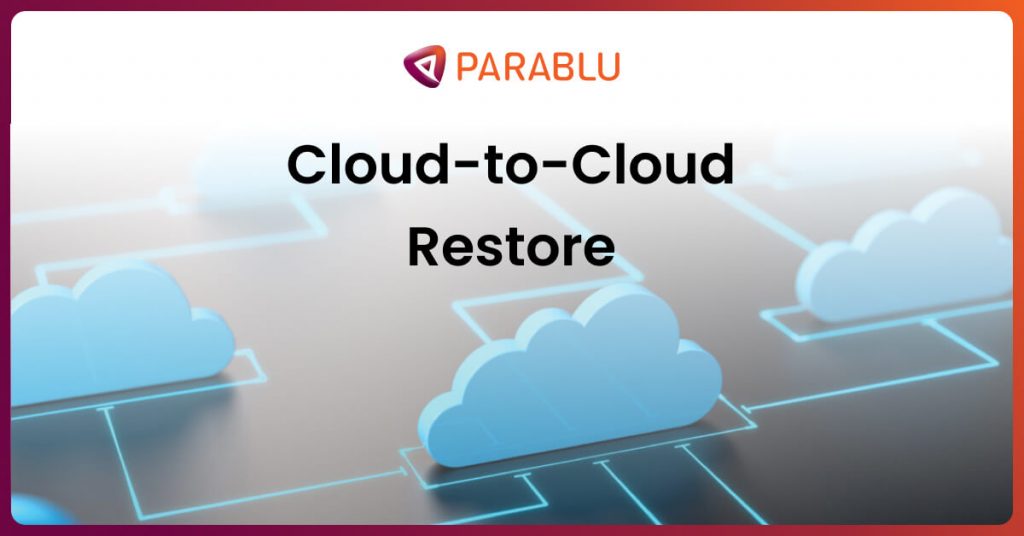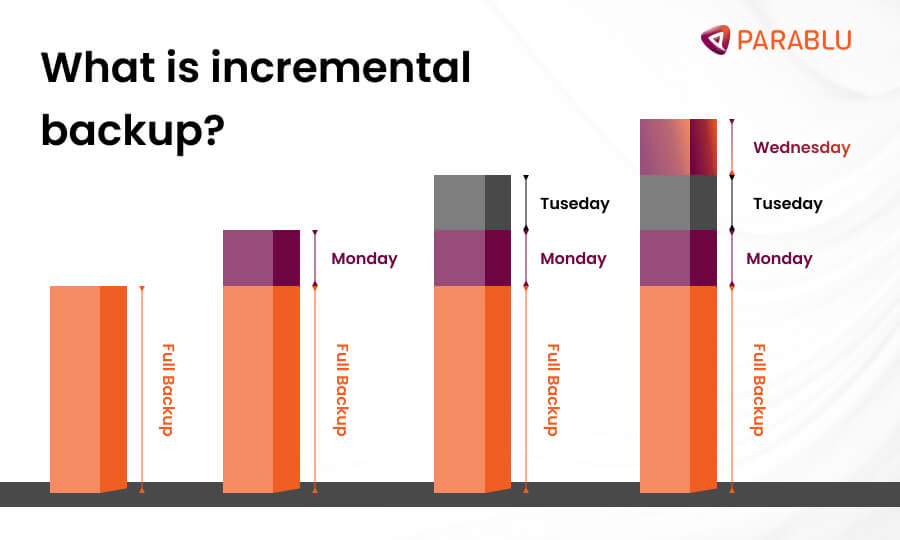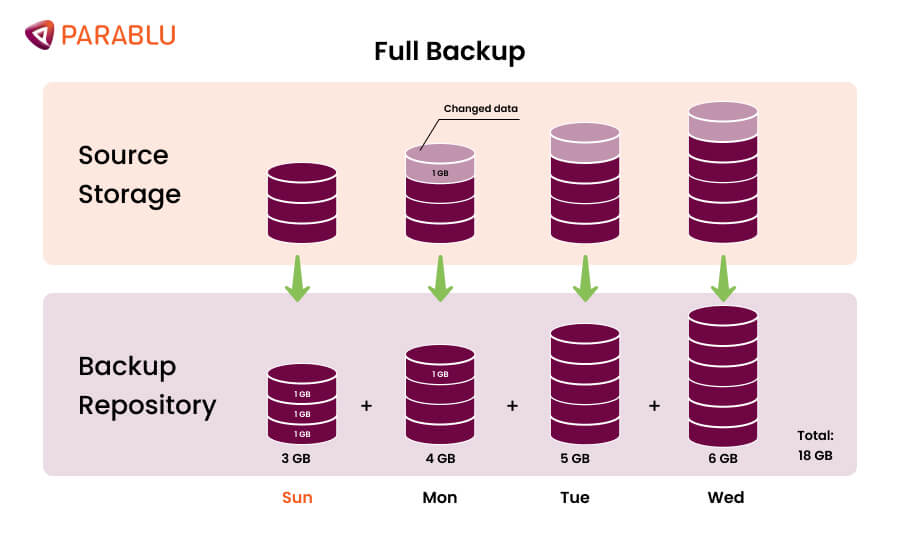Cloud-to-Cloud Restore: Ensuring Data Security and Disaster Recovery in the Cloud Era

Last year, 95% of organizations faced some kind of data outage or disruption. The impact of these incidents was overwhelming, with an average cost of $1.7 million per incident.
This statistic shows how important it is for organizations to have a data safety plan. Organizations need robust measures to ensure data resiliency and effective disaster recovery.
One such solution is cloud-to-cloud restore.
Backup is the key to recovering and restoring your data in such scenarios. But traditional backup methods may not be enough in the cloud era. The data is available across many cloud services and platforms — it is an easy target for cyber threats. This is why cloud-to-cloud backup strategies have emerged as a savior.
In this blog, we’ll talk about the various cloud-to-cloud restore options available. Also, how cybersecurity companies like Parablu are revolutionizing data recovery. From cost-effectiveness to rapid recovery, we’ll uncover cloud-to-cloud restore’s advantages. We’ll make sure you have all the information you need to thrive in the cloud era.
Let’s begin!
Understanding Disaster Recovery to Explore the Power of Cloud to Cloud Restore
Disaster Recovery is crucial for organizations. But what exactly do they mean by disaster recovery?
It’s an organization’s ability to withstand unexpected events like data loss or corruption. It involves preparing for and recovering from such events to ensure operational continuity. Disaster recovery planning plays a crucial role in achieving data resiliency.
As we always say, it’s not how hard you fall that matters, it is how rapidly you can recover.
Cloud-to-cloud restore is an essential component of disaster recovery plan. It creates redundant backup copies of data stored in separate cloud environments. This approach ensures the resiliency of critical data by providing extra protection. In the event of a data loss, the redundant copies of data can be accessed and restored. This minimizes downtime and ensures business continuity.
Cloud-to-cloud restoration simplifies the recovery process by eliminating the need for physical infrastructure. Also, it streamlines data resiliency procedures. It’s a cost-effective and scalable solution.
What more? It is also flexible! Organizations can choose and scale their cloud storage needs based on their requirements.
Disaster Recovery: Strategies for Cloud-to-Cloud Backup
When it comes to cloud-to-cloud backup, there are two main approaches to consider:
Incremental backups:
- Focuses on saving only the changes made since the last backup
- Quick and efficient, requiring less storage space

Full backups:
- Safeguards all data, regardless of whether it has changed since the last backup
- Offers the highest level of data protection
- Demands more storage space and time to complete

To choose the right backup frequency for your organization, consider the criticality of your data and rate of change.
For evolving and mission-critical data, frequent backups are necessary. They ensure quick recovery during data loss or corruption. For less critical data, less frequent backups may be acceptable.
Do a thorough audit and find the right balance between backup frequency and the associated costs. Knowing all these details is key to developing an effective backup strategy. By implementing a well-designed cloud-to-cloud backup strategy, you can rest assured. Your data is safe, available, and ready to support your organization’s success.
Choosing the Right Cloud-to-Cloud Backup Provider
Along with choosing the right backup frequency, you must also choose the right cloud-to-cloud backup provider. But, with many factors to consider, the selection process can be daunting.
To make the decision easier for you, we are sharing a few important points:
Cost:
- Look for a provider that offers affordable options. Go through their pricing plans, storage costs, and any extra fees.
- Consider the cost of ownership, including storage, bandwidth, and related expenses.
Reliability:
- Ensure the provider has a track record of reliability and uptime.
- Check their service level agreements, guarantees, and support options.
- Look for backup architecture, redundancy, and failover capabilities.
Security:
- Make sure your data is stored and protected from unauthorized access.
- Choose a provider with strong encryption, access controls, and compliance with industry standards. GDPR, HIPAA, and PCI DSS are a few of the industry standards you need to check.
- Check for security certifications and audits like ISO 27001 and SOC.
Read More: 5 Key Considerations for Choosing the Right Endpoint Backup Solution Provider
Empowering Businesses with Robust Disaster Recovery
Is your business prepared for the unexpected?
In today’s fast-paced world, organizations face many risks that can disrupt operations. That’s why disaster recovery planning is important.
You should focus on and take the following steps:
- Identify critical data and applications
- Check potential risks
- Develop strategies to reduce those risks
- Include procedures for backing up and restoring crucial data in the plan
- Assign roles and responsibilities to team members involved in the recovery process
- Regularly test and confirm the plan to ensure it works
These steps reduce the chances of data loss or corruption during a disaster.
Empowering Businesses with Robust Disaster Recovery
The security of data during cloud-to-cloud restore processes is of utmost importance. Implementing robust measures is essential to protect sensitive information. Key measures that play a crucial role in securing data are:
- Encryption: Scramble data to limit access. Ensure only authorized users can decrypt and view information.
- Access Controls: Authenticate and allow users, granting data access only to those with permission.
- Network Security: Deploy firewalls and intrusion detection systems to safeguard data from cyber-attacks.
- Strategy: As the reliance on cloud services continues to grow, organizations must focus on cybersecurity.
These measures serve as essential pillars in protecting data during cloud-to-cloud restore processes. The following cybersecurity considerations are inculcated seamlessly inside Parablu’s solution. Advanced encryption protocols scramble the data so that it remains inaccessible to unknown users. Rigorous access controls and robust network security layers further strengthen protection for sensitive information during cloud-to-cloud restore operations. This comprehensive strategy aligns with Parablu’s commitment to secure and reliable data recovery solutions.
Read More: Why Enterprises Need Zero Trust Security in Backup Solutions
How Parablu’s Solution Ensures Cloud-to-Cloud Recovery?
Parablu’s solution offers seamless Cloud-to-Cloud recovery using advanced technology and robust security protocols. Businesses can rely on this module for secure and effective data protection.
Here’s how it works:
- Encryption: Parablu uses robust encryption for data at rest and in transit, where the key to security lies with the user through encryption keys managed by the user.
- Granular Backup and Recovery: This entails the granular ability to back up and recover only the intended files, folders, or systems to quickly recover critical data.
- Continuous Data Protection: Real-time tracking of changes in the data ensures that only the latest versions are recovered.
- Multi-Cloud Support: It supports multiple cloud platforms; hence, one is certain of no vendor lock-in and can tap into various features available from the different clouds.
- Automated Scheduling of Backups: Automating the process of manually creating backup schedules. This ensures periodic data backups without human intervention, thereby minimizing potential data loss due to human failure.
- Compliance and Reporting: Make sure compliance reports and audit trials respond to regulatory requirements. This is done by providing insight into backup operations and recovery processes.
- User-Friendly Interface: The system provides an intuitive interface. This helps in easily managing all tasks from one place—in an at-a-glance dashboard.
- Scalable Architecture: A scalable architecture that can keep up with growing volumes of data will ensure performance and security protection.
We are a reliable and cost-effective backup solution that ensures business continuity in disasters. Parablu’s comprehensive solution minimizes data loss risks.
Final Words:
Gone are the days of relying on traditional backup methods. Harness redundant backup copies across many cloud services and platforms with cloud-to-cloud restore. This approach minimizes downtime, simplifies recovery, and eliminates physical infrastructure needs. Unlock the untapped potential of cloud computing and revolutionize your data management strategy!





